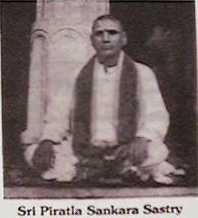Gayaka Ratna Sri Piratla Sankara Sastry
Pradhama Guru
Gayaka Ratna Sri Piratla Sankara Sastry
(By his disciple, Gayaka Ratna Vinjamuri Varadaraja Iyengar - 1952)

I will make an attempt to write, in short, what I know about my first teacher Brahmasri Piratla Sankara Sastry, an accomplished doyen of Nadayoga. For a long time, he had decorated the Palace of Muthyala Samsthanam, in Krishna District, as Asthana Vidwan. Later, by the direction of the Maharaja, he moved to Guntur to tutor the daughter-in-law of the Rani of Chintalapalli and lived there for a long time and contributed immensely to the development of Musical studies there. Having come to know about him, Sriman Vinjamuri Bhavana Chariar, the statesman of the place and a promoter of the arts, and, my beloved Father, appointed him to give Music lessons to my sisters. Every day, he would come during evening hours and teach them. They were my younger years. After coming back from school, I used to listen to the lessons with much interest and concentration, which was the reason for the birth of interest in Music, in me. While I was in school, he started teaching Music to me too. He would teach approximately from 8.00 p.m. to 9.00 p.m. He started me with an Ata Tala Varnam in the Ragam Reetigowla. After that, he taught me Ata Tala Varnams in Kalyani, Bhairavi, and Kambhoji and then started me with the Kritis by teaching the Thyagaraja Kriti "Sambho Mahadeva" in the raga Kamavardhani. Later, he taught me a number of difficult and apoorva (not well-propagated) kritis with Neraval and Kalpana Swara singing and put me in the path to attain my goal and helped with my development. I am writing below his life history as narrated by him to me one day, when he noticed my curiosity.
The birth of the doyen was on Tharaka Nama Samvatsara Bhadrapada Suddha Chaturdasi day. That is, on the Ananthapadmanabha Chaturdasi day in the year 1884 AD. His father was Sri Piratla Sreesaila Sastry and the mother was Smt Pichamma. His brother, Sri Piratla Sivaramayya was a talented violinist. His birthplace was Jayanthipuram in Krishna district, near Vedadri Kshetram. It is a very small village on the banks of Krishna. As his parents were very orthodox, they enrolled him in Akiripalli Veda Patasala (Vedic School) where Sri Sankara Sastry studied Sanskrit, Telugu and the four Vedas. Thereafter, due to his interest in music, at the age of eighteen, he went to Madras and joined Sri Veena Kuppaier's son Sri Muthyalapeta Thyagaier and learned music for many years in the ancient Gurukula (live-in student at Guru's place) tradition, learnt all intricate details of the art of music and returned back to his village. Having realized his mastery over the art and his rich voice, the king of the nearby Muthyala Samsthanam appointed him as the Palace Musician. As the Palace Musician, he traveled to many places and gave performances. On one occasion, when he was performing at Madras, his music was listened to by the genius Rt. Honourable Sreenivasa Sastry. In that concert, the artist, while he sang Patnam Subrahmanya Iyer's composition, "Ninnu Joochi Dhanydaithi" in the raga Sowrastra, at the charanam "Sakala Lokaadhara - Sacchidaakara", he sang using the Suddha Daiwatam, as in the old tradition. Having listened to this, when Rt. Hon'ble Sastry wrote about Sankara Sastry in the "The Hindu" paper the next day, he wrote that Sankara Sastry belonged to the Sishya Parampara of saint Thyagaraja (the lineage of the disciples of Thyagaraja) and that he knows a lot of intricacies in the art of Music. He suggested that the music lovers should arrange for his performances and learn great many things from him. Ever-since, the famous musicians like Sriman Tiger Varadachariar, Sriman Ariyakudi Ramanuja Iyengar and Sri Maharajapuram Viswanatha Iyer, developed a liking for him. Since then, he got the name as the expert in Lakshya and Lakshana (Grammar and diction). Once, when he was in Guntur, he received a letter from the Madras Music Academy stating that he was appointed as the expert committee member. Thereafter, he attended the yearly held December Music festival there. Every year he would participate in the discussion of different Raga Lakshnams. One year, they were discussing Sowrastra Raga Lakshanam. Some felt that it was a Janya of the 16th Mela Chakravakam and the others felt that it was the Janya of the 17th Mela Suryakantham. Then, they asked The Master for his opinion. Then, he sang the Charanam of the song, "Ninnujuchi Dhanyudaithi" as, "GMPDa DaND PaDP MaPM GRi Sa …CchiDaaKa … … … Ra .." with Suddha Daivata Prayogam and said, that was the ancient method and his Guru Tiruvattiyur Thyagayyer taught him in the same way and therefore Sowrastra is the derivative of Suryakantham. Sri Harikesanallur Muthiah Bhagavatar attested to his method by saying that it was what had been "traditionally-followed", the ancient method. The Academy finalized the same.
Shankara Sastry was a good-hearted man. As the Asthana Vidwan, at the time of the marriage of the daughter of king of Muthyala, he arranged for my concert. For that, they arranged M. S. Gopalakrishnana's father Parur Sundaram Iyer's Violin, Madras Venu Nayakar's Mridangam and T. S. Bilvadri Iyer's Ghatam. The Programme took place in the evening, for about four hours. The felicitation was with RS. 1116.00. At that time, the Raja of Challapalli attended my concert along with his family, and, at the end of the concert he called me asked me to perform at the wedding of his brother, which was to take place the following month. That also went on successfully due to the grace of my teacher (Sadguru Kataksham).